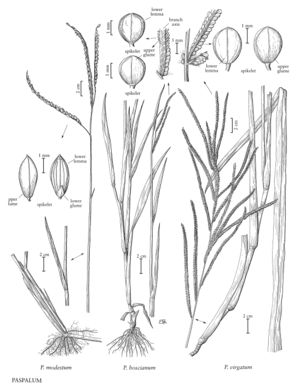Paspalum boscianum
Plants annual. Culms 15-96 cm, erect or prostrate, often rooting at the lower nodes; nodes glabrous. Sheaths glabrous; ligules 1-3.2 mm; blades to 56 cm long, 2.2-15 mm wide, flat. Panicles terminal, with 1-10 (28) racemosely arranged branches; branches 1.2-8.2 cm, diverging; branch axes 0.7-2.3 mm wide, glabrous, broadly winged, wings about as wide as the central portion, margins scabrous, terminating in a spikelet. Spikelets 2-2.2 mm long, 1.3-1.8 mm wide, paired, appressed to the branch axes, glabrous, broadly elliptic, obovate, or orbicular, light to dark-brown. Lower glumes absent; upper glumes glabrous, 5-veined, margins entire; lower lemmas glabrous, 3-5-veined, margins entire; upper florets dark glossy brown. Caryopses 1.4-1.6 mm, white. 2n = 40.
Distribution
Puerto Rico, Md., Miss., Tex., La., Pa., Ala., Tenn., N.C., S.C., Va., Ark., Ga., Ky., Fla.
Discussion
Paspalum boscianum grows in moist to dry, disturbed areas, and at the edges of forests. It is native from the southeastern United States through the West Indies and Mexico to Brazil. The California record came from a weed in a rice field.
Selected References
None.
Lower Taxa
"decumbent" is not a number.
